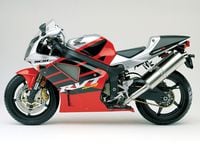Racing is a hotbed of innovation, but sometimes the only way to get ahead is to go along. From 1988 to 1999 Honda’s V-4s brought home just three World Superbike titles; all but one of the rest went to Ducati V-twins, aided in part by their 1,000cc displacement advantage compared to the mandated 750cc ceiling for fours. So in late 1999 Honda brought out a 1,000cc V-twin. The payoff was immediate and gratifying. Colin Edwards grabbed the WSB title in 2000 and again in 2002, when Nicky Hayden also rode off with the AMA Superbike title. The production version of that bike, called the RC51 (a.k.a. the SP1 from ‘00–’01, and the SP2 from ‘02 on), is one of the tastiest treats ever to sneak out the back door of the racing shop.
The RC51’s engine was a tour de force for its time and still impresses today with its gear-driven cams, huge 54mm throttle bodies, and two injectors per cylinder. In the interests of long-term reliability on the street, the compression ratio was a relatively mild 10.8:1 and the redline set at 10,000 rpm. Rear-wheel horsepower was a claimed 133, with torque at 71 pound-feet. (We got 118.5 hp and 72.1 pound-feet of torque back in 2000.)
The RC51’s Superbike-bred chassis was stiff and strong, with steering geometry better suited to road riding than roadracing. The bike’s weight—489 pounds wet by our scales—would have raised eyebrows in pit lane but was on par with contemporary competitors from Ducati and Aprilia. One characteristic that crossed over from the track was high fuel consumption and short range. We got 38 mpg average in our August 2000 road test, but owners report higher consumption. The tank holds just 4.8 gallons.
In 2002 a host of upgrades appeared on the SP2, including parts plucked from the race kit’s parts list, such as even bigger throttle bodies (62mm), 12-hole fuel injectors, improved fuel mapping, a sharper-handling chassis with a near race-spec swingarm, improved cooling to address overheating issues on the early models, and an 8-pound weight loss. Riders who’ve sampled both say the later model is the one to get. All models are fairly easy to work on, have good parts availability, and respond well to minor performance mods like slip-ons and remapped fuel injection.
Watch for the usual signs of sportbike abuse—damaged bodywork, a worn or dirty chain, torched tires—and try very hard to get a test ride. Bad gas and old spark plugs are common causes of rough running and are easy to fix, but if the transmission jumps out of gear under load or gives you a false neutral, or the clutch is grabby, you could be in for a big repair bill. Engine oil consumption is a major concern; make sure the oil level is correct, and check the oil itself to see if it’s been changed recently. The RC51 was geared very tall, and many riders dropped the front sprocket one tooth for better acceleration.
The RC51 was deleted from Honda’s lineup after the 2006 model and is a challenge to find today. If you’re just looking for an unusual daily rider or a weekend warship, the SP1 will do fine. But if trackdays are your thing, hold out for an SP2. This is one of the few used bikes on which carefully chosen aftermarket accessories are worth a bump over the book price.
Brawny 90-degree V-twin power, sharp handling, racetrack pedigree. Call it the Honducati (everybody did back in the day).
An extreme thirst for gas, ride quality that sits somewhere between firm and punitive.
Balky transmission, low oil, grabby clutch, owner who won’t give test rides.
A real sleeper that’ll open your eyes wide every time you ride it.
2000 / $3,5702001 / $3,8802002 / $4,2952003 / $4,7502004 / $5,2152005 / $5,7402006 / $6,270
Aprilia stole a little of Ducati’s thunder with the introduction of the RSV1000 Mille in 1998. Edgy Italian styling, top-shelf chassis components, and a rorty Rotax-built V-twin made the Mille a formidable competitor among the exotic sportbikes. They’re still around in good numbers. Watch for electrical gremlins, mostly, since the Rotax engine is nearly bulletproof.
The last of the 916-derived superbikes from Ducati, the 998 debuted the punchy Testastretta for the first time in mass production. (The 996R used the engine in limited quantities, previously.) Fast, sexy, and very well developed, the 998 was the ultimate expression of this platform, made all the more desirable thanks to the successor 999’s controversial styling.
Honda’s tamer, somewhat more practical entry to the V-twin class was the Super Hawk. Loved by enthusiasts for its characterful V-twin, good chassis, and neutral handling, the VTR was hamstrung mostly by a huge appetite for fuel and a small gas tank. Beware of silly modifications, and make sure the carburetors are clean; the bike should start easily.














/cloudfront-us-east-1.images.arcpublishing.com/octane/VZZXJQ6U3FESFPZCBVXKFSUG4A.jpg)
/cloudfront-us-east-1.images.arcpublishing.com/octane/QCZEPHQAMRHZPLHTDJBIJVWL3M.jpg)
/cloudfront-us-east-1.images.arcpublishing.com/octane/HXOUJXQWA5HBHGRO3EMJIGFMVI.jpg)

/cloudfront-us-east-1.images.arcpublishing.com/octane/3TIWWRV4JBBOLDVGRYECVVTA7Y.jpg)
/cloudfront-us-east-1.images.arcpublishing.com/octane/KIX5O23D5NAIBGFXBN3327DKZU.jpg)
/cloudfront-us-east-1.images.arcpublishing.com/octane/7GJYDUIPXRGMTMQKN6ONYOLBOU.jpg)
/cloudfront-us-east-1.images.arcpublishing.com/octane/MUQLOVLL2ZDGFH25ILABNBXKTI.jpg)
/cloudfront-us-east-1.images.arcpublishing.com/octane/TNOU5DNE2BC57MFPMGN2EIDXAM.jpg)
/cloudfront-us-east-1.images.arcpublishing.com/octane/GTCXACQGJ5HAPDTGWUQKDEH44E.jpg)
/cloudfront-us-east-1.images.arcpublishing.com/octane/S35YGSEMEZB4BLTDJTSZPF4GLA.jpg)
/cloudfront-us-east-1.images.arcpublishing.com/octane/5UOT6HPX2JFMRJAX6EH45AR4MQ.jpg)
/cloudfront-us-east-1.images.arcpublishing.com/octane/OKWOJWAKP5EP3OACCRRWPCIX2Q.jpg)
/cloudfront-us-east-1.images.arcpublishing.com/octane/2WF3SCE3NFBQXLDNJM7KMXA45E.jpg)
/cloudfront-us-east-1.images.arcpublishing.com/octane/G4MG6OUCJNBSHIS2MVVOTPX65E.jpg)
/cloudfront-us-east-1.images.arcpublishing.com/octane/IIGGWFOTOJGB7DB6DGBXCCMTDY.jpg)
/cloudfront-us-east-1.images.arcpublishing.com/octane/QSTCM6AVEZA5JJBUXNIQ3DSOF4.jpg)
/cloudfront-us-east-1.images.arcpublishing.com/octane/U4I7G625B5DMLF2DVIJDFZVV6M.jpg)
/cloudfront-us-east-1.images.arcpublishing.com/octane/B6XD6LS6IVCQPIU6HXDJSM3FHY.jpg)
/cloudfront-us-east-1.images.arcpublishing.com/octane/ICL63FEDDRDTTMINYICCEYGMDA.jpg)
/cloudfront-us-east-1.images.arcpublishing.com/octane/FCGZHQXRBZFLBAPC5SDIQLVF4I.jpg)
/cloudfront-us-east-1.images.arcpublishing.com/octane/WNOB6LDOIFFHJKPSVIWDYUGOPM.jpg)

/cloudfront-us-east-1.images.arcpublishing.com/octane/X33NU3E525ECRHXLNUJN2FTRKI.jpg)